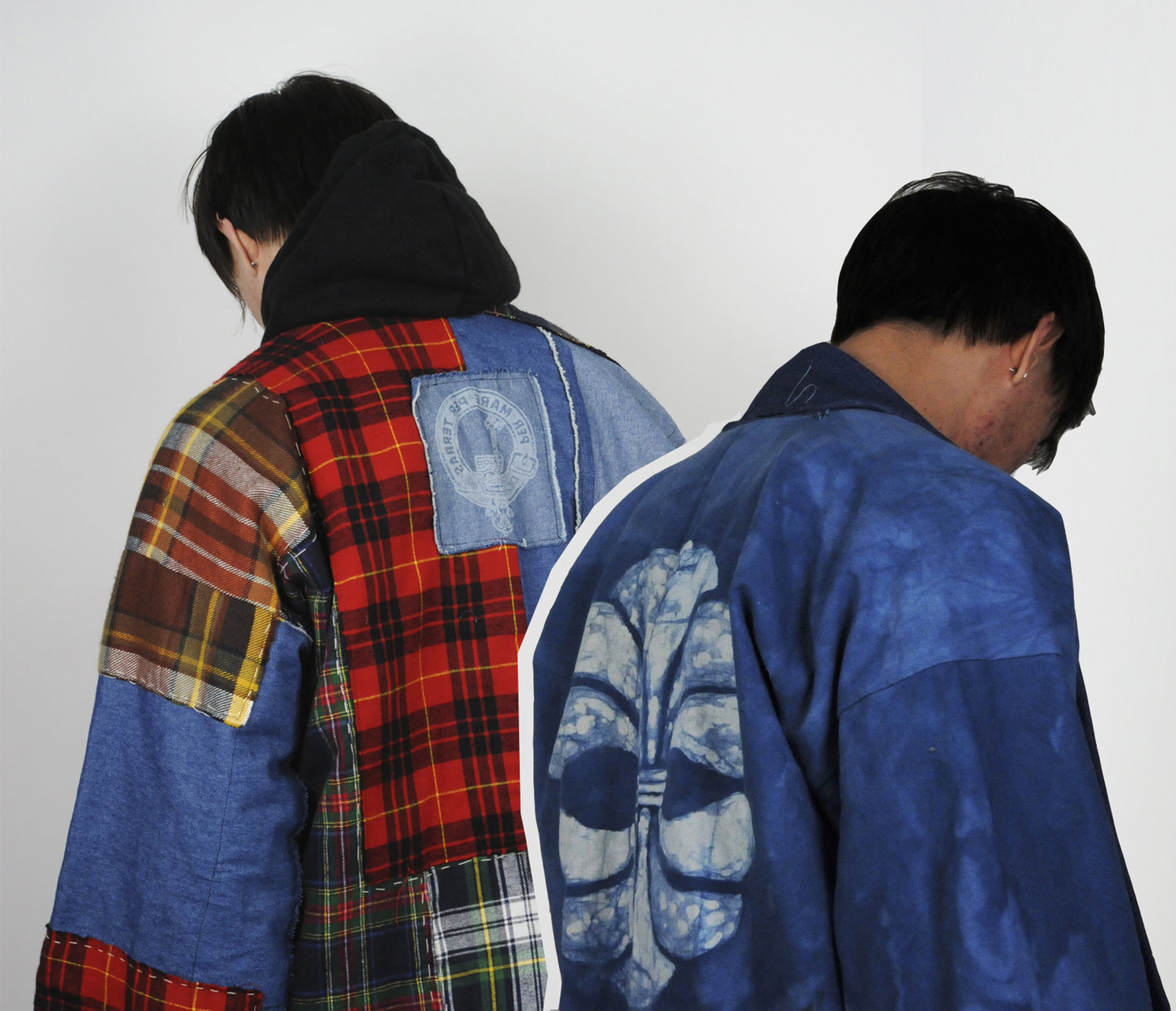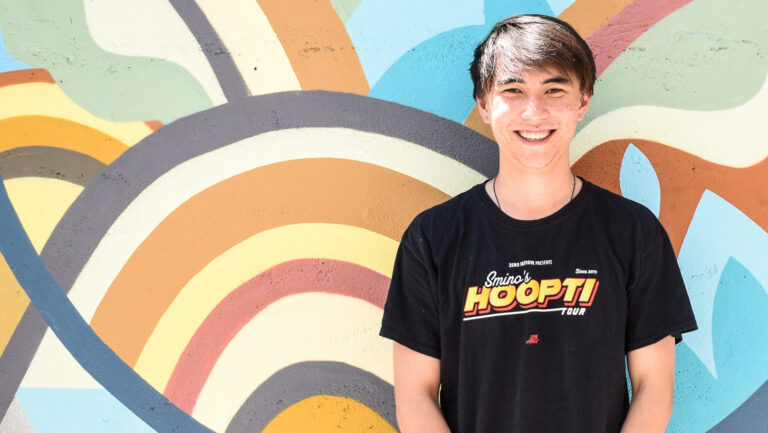Working with textiles, Dante Betsch’s work comes from a place that is both political and personal. Political, not in the sense that he is advocating for a certain political position, but rather he is advocating for the space to be himself without the confines of external stereotypes thrust upon him by other’s political positions. Personal, in the sense of reflections of where he has personally been, where he grew up and what confronts this young artist as he begins his professional career. He is quick to point out that his work is the way that he tells his story.As part of the Harwood Art Center’s annual group show SURFACE: Emerging Artist of New Mexico on display through July 25, Betsch was awarded the 2019 Harwood Art Center Solo Exhibition Award as well as the Valerie Roybal Award, meaning in short that we can expect to see more from him in the near future. Weekly Alibi sat down with Dante Betsch to talk about where he is from, his work and what we can expect from him in the future. The following is an edited version of that interview. Weekly Alibi: You’ve said your Japanese-American identity informs your work. How?Dante Betsch: I guess it is informed by my Japanese-American heritage because there is a sense of not belonging in both cultures. Not that I don’t fit in or anything, but in Japan there is a huge sense of tradition and if you are not pure, as some people would put it, you’re always seen as an outsider. And here, being the only Japanese person I knew my entire life until going to college, I always felt like I was a little different. That honestly created great friendships for me throughout my childhood just because I met kids who came from Nicaragua to Ghana to all over the world and there was just this sense that everyone came from their own background and their own sense of unbelonging, but from that we all united together and created friendships based off our own personal interests. My soccer team was the most diverse team I’ve ever experienced.The Highland Hornets?Eighty languages were spoken there. I didn’t feel this sense of segregation. At Michigan [the University of Michigan], I really strived for my college being diverse, I saw the classrooms of these 400-plus lecture rooms and I saw these kids. They all looked super diverse and I was like, “Okay, Michigan is my place.” But then when I went there, it was really segregated. It didn’t feel like people were basing their conversations with me off of my own personal interests, it was more just, “Oh, you’re Japanese then you must have done this or you must have experienced this.” In Japan, it was weird because I always felt like I was white or an outsider. You grew up in Albuquerque. It’s a pretty multicultural city. Who is the other here?The other doesn’t really exist here. The other is anyone that you meet on the side of the street or anyone that isn’t part of your circle of familiars. You have an interaction with a stranger out here and everyone is so welcoming, so just open hands. It doesn’t matter what background you come from, socio-economic or racial. In my experiences in other places, there is this sense of “other.” There is this of, “Oh, I don’t know about you. I don’t know if I can approach you.” I kind of want to get rid of that. New Mexico is a great place for that.You always think of America as this melting pot, fruit salad or whatever term it is now, but I truly think New Mexico is that because you see all these migrants from completely different background with such interesting stories. At the same time, no one is having huge racial fights or arguments. Everyone is really just trying to unite as one community of being New Mexican. I appreciate the fact I came from this background.Cultural heritage is by definition about the past, but cultural identity doesn’t have to be. Is your work looking forward or backward? I think it is a sense of looking at what has happened in the past to move forward into the future. It is a very Japanese way of thinking, but it’s like, remember your past so you can forgive and move forward. Looking at cultural identity, it’s this idea of what are the stigmas? What are the things that have been impacted by race in the past? Have you followed the controversy over Kim Kardashian’s “Kimono” underwear line? Thoughts?I did fashion design out in Central Saint Martins and I’m losing a lot of hope in the whole fashion industry. There’s always something with the fashion sphere. Gucci got in huge trouble for having ski masks that resembled blackface. I don’t take it that seriously, because the more weight you put on these cases, the more they are able to publicize these things. I don’t think they see the ridiculousness of it. The less attention I give to these cases is the better way out. Much of your work is wearable. Where is the line between fashion and textile? Where would you place your work within that continuum?When it comes to fashion versus textiles, I think they are intertwined. The greatest fashion pieces I’m in love with are based off the textile and the process of making the fabric. I think there is a huge story to be told there, especially from my heritage on the Japanese side. There are thousands of years of Japanese textile practices that I think can create this conversation about how to incorporate the past with the new. My work, I do like this idea that the viewer can picture themselves in it. There is a wearable aspect, but it is completely impractical to wear some of my garments in public. It’s very performative in that sense. Are they designed to be hung on the wall or are they designed to be carefully worn?So far, most of the pieces I’ve made are for me, to tell my story. Yes, I would want them to be worn. Absolutely. That was the whole intention. How I sewed everything was the idea that, okay it is going to get kind of roughed up by the weather. Right now my artwork is in the Harwood. I would like to transcend artwork past these gallery spaces. Not everyone is privileged to be able go into these gallery spaces or feel welcomed. I know they are usually free, but there is this sense that oh I shouldn’t go in there. I feel like I can wear my artwork that is political to an extent. I can then wear it out in public and the audience is completely random. Then you can create a conversation that is not so biased to who can go into a gallery.You have been awarded a solo show next year at Harwood. What will you show?That is still in the works. It was a total shock for me and I’m super grateful to Harwood. I want to dive deeper into what my background means and what it means to be Japanese-American. I do want to tell my story as a biracial individual just to add to this larger story that is being told of what it means to be American and how we view “the other.”
SURFACE: Emerging Artists of New MexicoHarwood Art Center1114 Seventh Street NWRuns through July 25










